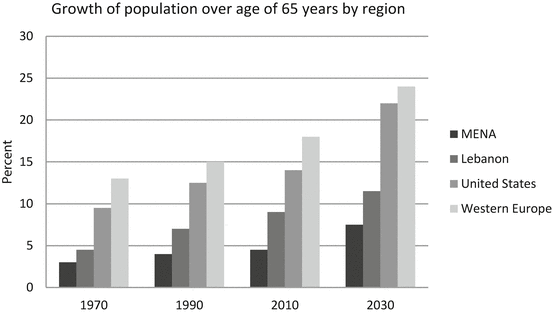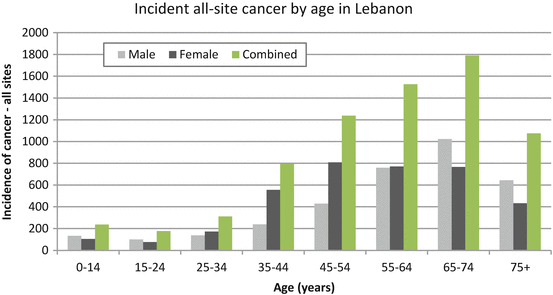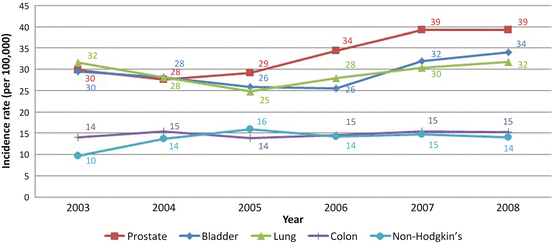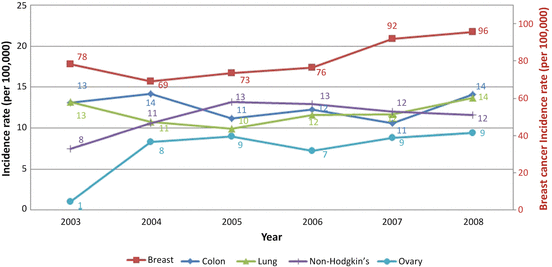Fig. 10.1
Map of Lebanon
It is estimated that just less than 10 % of the population is above the age of 65 years and 1.5 % above the age of 85—a small proportion compared to Western Europe and the USA, but quite high regionally. The United Nations estimates that the average life expectancy in Lebanon will rise from approximately 74 years for men and 77 years for women (as little as 50 years ago, it was 60 years) to 78.7 years between 2014 and 2050, leading to an increase in the median population age from 28.8 to 41.7 years as well as the percentage of older population aged 60 years and above from 10.3 to 25.8 % [13] (Fig. 10.2).


Fig. 10.2
Growth of population over age 65 years by region. Compiled from multiple sources, and rounded to nearest half percent. MENA Middle East and Northern Africa. Source: Daher M, Hajjar RR. Palliative care for cancer patients in Lebanon. In: Silbermann editor. Palliative Care to the Cancer Patient: The Middle East as a Model for Emerging Countries, 1st edition. New York: Nova Publishers, 2014: 125–40
With an aging population, comes chronic, costly, and serious illness, including many types of cancers, of which the Lebanese health care system is ill-prepared to deal with. All-cause cancer incidence peaks at around age 70 [14, 15] (Fig. 10.3).


Fig. 10.3
Incident cancer cases in Lebanon by age-2003. All-case cancer excludes non-melanoma skin cancer. Source: National Cancer Registry (NCR). Cancer in Lebanon 2004 with an update of 2003, Beirut, Lebanon
The number of new cases of cancer in Lebanon has increased steadily over the past decade, according to the National Cancer Registry of the Ministry of Health and the World Health Organization (WHO). In 2004, almost 7200 new cases of cancer were reported in Lebanon, compared to over 8400 in the most recent report [14, 16].
This worrisome trend is not entirely due to aging; expanded screening efforts and improved registration methods have likely contributed significantly. It is estimated that by 2030, the number of new cancer cases will approach 12,000 [17].
The situation in Lebanon is as alarming as in ME countries and other countries in transition:
Incidence: The National Cancer Registry (NCR) w as implemented within the Ministry of Public Health NCD Programme and was integrated into the Epidemiological Surveillance Programme (ESP) in 2007. Cancer notification has been made mandatory through Ministry of Public Health Decision 1/511 in 2002. The first annual report on national cancer incidence data was published in 2003 (about 7400 cases), noting age-standardized incidence rates of 191.3 and 190.7 per 100,000 for males and females, respectively [16].
Top cancer sites: The highest burden among cancers in both sexes is breast, prostate, lung, bladder, non-Hodgkin lymphoma, and colorectal cancers, all of which form approximately 65 % of cancer cases. The present incidence rates for the five most common cancers in males and females reported that cancers of prostate, bladder, lung, colon, and non-Hodgkin were the most common among males, and cancers of the breast, colon, lung, non-Hodgkin, and ovary were the most common among females. During the period (2003–2008), reported by the NCR, males and females presented with an overall 4.5 % and 5.4 % annual increase, respectively. Significant increases were observed for cancers of the liver and prostate among males, and for cancers of the liver, thyroid, and corpus uteri among females [16, 17] (Figs. 10.4 and 10.5).



Fig. 10.4
Cancer incidence of the five most common cancers in males (2003–2008)

Fig. 10.5
Cancer incidence of the five most common cancers in females (2003–2008)
Although there are no reliable data on cancer incidence and mortality in Lebanon in recent years, (the last official report was about 8500 new cases in 2008), estimates from the International Agency for Research on Cancer (IARC) indicate 9059 new cancer cases in 2012 (4321 cases among men and 4738 cases in women) per annum. The estimated number of deaths from cancer in 2012 was 4831 (2588 cancer deaths among men and 2243 among women) [GLOBOCAN 2012] (Tables 10.1 and 10.2).
Table 10.1
Cancer incidence among top five cancer sites (Source: GLOBOCAN 2012)
Cancer incidence estimates | Total 9059 | ||||||||
|---|---|---|---|---|---|---|---|---|---|
Male | Female | ||||||||
Cancer site | Number of cases | % of cancers | Crude rate | ASRa | Cancer site | Number of cases | % of cancers | Crude rate | ASRa |
Prostate | 807 | 19 | 38.5 | 37.2 | Breast | 1934 | 41 | 88 | 78.7 |
Lung | 625 | 14 | 29.8 | 30.2 | Colorectum | 338 | 7 | 15.4 | 13.5 |
Bladder | 618 | 14 | 29.5 | 29.1 | Non-Hodgkin lymphoma | 282 | 6 | 12.8 | 11.5 |
Colorectum | 407 | 9 | 19.4 | 19.1 | Lung | 272 | 6 | 12.4 | 11 |
Non-Hodgkin lymphoma | 310 | 7 | 14.8 | 14.7 | Corpus uteri | 187 | 4 | 8.5 | 7.7 |
Total** | 4321 | 100 | 206.3 | 203.9 | Total** | 4738 | 100 | 215.7 | 192.8 |
Table 10.2
Cancer mortality among top five cancer sites (Source: GLOBOCAN 2012)
Cancer mortality estimates | Total 4831 | ||||||||
|---|---|---|---|---|---|---|---|---|---|
Male | Female | ||||||||
Cancer site | Number of deaths | % of cancers | Crude rate | ASRa | Cancer site | Number of deaths | % of cancers | Crude rate | ASRa |
Lung | 559 | 22 | 26.7 | 26.9 | Breast | 599 | 27 | 27.3 | 24 |
Prostate | 411 | 16 | 19.6 | 17.1 | Lung | 240 | 11 | 10.9 | 9.6 |
Bladder | 243 | 9 | 11.6 | 11 | Colorectum | 190 | 8 | 8.6 | 7.4 |
Colorectum | 229 | 9 | 10.9 | 10.5 | Non-Hodgkin lymphoma | 166 | 7 | 7.6 | 6.6 |
Non-Hodgkin lymphoma | 183 | 7 | 8.7 | 8.6 | Ovary | 116 | 5 | 5.3 | 4.7 |
Total** | 2588 | 100 | 123.5 | 119.5 | Total** | 2243 | 100 | 102.1 | 89.6 |
Particular Cancers in Lebanon
Breast cancer : In Lebanon, the incidence of breast cancer among women in general is increasing (APC = 5.4 %) and is projected to continue to cause the highest morbidity burden compared to other cancers (33–44 %). It occurs at a younger age (50 % of all breast cancer patients are below the age of 50), with a median of 50 years, compared to western countries where the median age approaches 63 years [18].
Moreover, these trends can be partly explained by widespread national breast cancer awareness campaigns since the early 2000s, with the wide adoption of mammography screening programs at reduced fees within NGOs and primary health care centers. The recommended age as the starting point for such a screening in Lebanon is 40 years. Awareness campaigns increase women’s personal motivation to utilize the diagnostic services and sensitize physicians to suspect and diagnose signs and symptoms of potential breast tumors [18].
Further, significant changes in social behaviors, like higher ages of marriage and less children, are likely to increase the likelihood of breast cancer incidence in the country [19]. Breast cancer is also altered by changes in dietary habits [20, 21]. The nutritional transition, characterized by an alteration in the food choices from the traditional Mediterranean diet to a more Westernized diet is currently underway [22, 23].
Bladder cancer : It was always surprising to observe a high incidence of bladder cancer relative to other cancers among males and females. Although the incidence of bladder cancer has been related to exposure to chlorinated water and its by-products and caffeine consumption [24, 25], smoking remains one of the most direct risk factors [26–28].
Stay updated, free articles. Join our Telegram channel

Full access? Get Clinical Tree





